Leonardo da Vinci was not just a great artist, but he was also a great scientist, inventor, and philosopher. There are many lessons we can learn from him.
We can learn from Leonardo da Vinci the power of being curious, especially as an artist. He taught us that we should never stop learning and discovering while at the same time not being afraid to experiment. As a prolific writer, he showed us the power of the written word and learning from nature.
Table of Contents
- Embracing Curiosity: Lessons from Leonardo da Vinci for Artists
- Frequently Asked Questions
- Related Questions
Embracing Curiosity: Lessons from Leonardo da Vinci for Artists
Leonardo da Vinci, a paragon of the Renaissance, exemplified the profound impact of curiosity in the realm of art. His relentless pursuit of knowledge, combined with a fearless approach to experimentation, sets an inspiring example for artists.
As an artist and a prolific thinker, da Vinci demonstrated the importance of continuous learning and observation, particularly from the natural world. His extensive writings further reveal the significance of the written word in enhancing understanding and creativity.
Through his life and work, Leonardo da Vinci teaches us the invaluable lesson of nurturing curiosity to fuel artistic growth and innovation. Her are some lessons we can all learn from Leonardo da Vinci.
We Learn From Leonardo That Great Artists Are Curious
Leonardo da Vinci taught us that a great artist is also someone curious about the world and life in general. Great art is not about sitting in a room painting by yourself, but about getting out in the world and finding inspiration there.
Leonardo da Vinci was extremely curious. He was constantly working on learning new things or thinking about new inventions. He is a man that seems to have never stopped learning or being curious, even until the end of his days.
As an artist, he understood the need to study the human body, so he was known to cut up at least 30 corpses to learn more about how the body functioned. He was one of the first people to cut up a human body to understand how the body functioned and worked.
Because Leonardo was so curious, he learned a lot about the human body and human form. Because of his research with the human body, Leonardo understood that the human body was a masterpiece.
He said this about the human foot:

“The human foot is a masterpiece of engineering and a work of art.”
Leonardo da Vinci
Leonardo showed us all that if we want to be great artists, we also need to be curious about the world around us. Leonardo was an individual who was always curious to be able to learn and discover new things.
Leonardo Shows Us To Never Stop Learning And Discovering
Leanardo never stopped learning and discovering. During his lifetime, many people just accepted what people told them. The Catholic Church was in control of the state and government where Leonardo lived.
Leonardo was much different; he constantly wanted to learn and discover. He was, by all accounts, a perfectionist that never stopped trying to improve.
Here is a great quote that he gave that talks about why he felt that men (and women) should constantly seek knowledge, learning, and discovery.
“Good men by nature, wish to know. I know that many will call this useless work… men who desire nothing but material riches and are absolutely devoid of that of wisdom, which is the food and only true riches of the mind.”
Leonardo da Vinci
Leonardo da Vinci Teaches That Experimenting Is Good
Leonardo also believes that we need to try new things and learn by experience and learning. One of his contributions to the art technique was the sfumato technique that he perfected.
The sfumato technique blended colors in a painting, so there are no visible lines or borders. The shades and colors gradually change to give an almost hazy effect.
Many artists use the sfumato technique to paint human faces as it gives a more realistic feel to the painting.
In speaking about us using our experiences to help us to learn, Leonardo da Vinci said this:
“Although nature commences with reason and ends in experience it is necessary for us to do the opposite, that is to commence with experience and from this to proceed to investigate the reason.”
Leonardo da Vinci
We Learn From Leonardo To Take Notes
One of Leonardo da Vinci’s essential legacies was his notebooks that he left behind. It is estimated that Leonardo left us over 13,000 pages of all kinds of notes that he left in about 50 different notebooks. There could be additional pages or notebooks which were lost over time.
In these notebooks, Leonardo wrote and drew about anything that interested him, from panting, color, shading, inventions, engineering, philosophy, warfare, physiology, anatomy, proportion, architecture, geology, and geography – to name a few. Essentially he wrote down everything that he thought about and felt was necessary.
Leonardo teaches us that words are essential, and through the words we write, we can also leave our legacy. We have learned many things we know about Leonardo da Vinci through the many pages and notebooks he left us.
Here is what Leonardo da Vinci told us about words and why they are also important:
“All knowledge which ends in words will die as quickly as it came to life, with the exception of the written word: which is its mechanical part.”
Leonardo da Vinci
Da Vinci Taught Us That We Can Learn A Lot From Nature
Leonardo da Vinci spent a lot of time studying nature. It was from nature, and when he looked at the birds in the sky, he thought about how the man could fly.
Nature inspires Leonardo in all aspects of his life and learning. He saw things that could help him in nature, from his art to medical studies to inventions and engineering.
In speaking of how Leonardo saw nature, he said this:

“Nature is the source of all true knowledge. She has her own logic, her own laws, she has no effect without cause nor invention without necessity.”
Leonardo da Vinci
Leonardo was a fantastic artist and human being. He has left us all with a lot of knowledge, notes, and incredible works of art.
But more than that, there are so many things that we can learn from him about our art and our own lives.
Anita Louise Art is dedicated to art education, great artists, and inspiring others to find and create their art. We love art that uplifts and inspires. #ArtToMakeYouSmile! #ArtToMakeYouHappy!
If you want to see any of my art, you can find out more by clicking here. If you are interested in what inspires me and my paintings, you can discover more by clicking here.
We have a free newsletter and would love you to be part of our community; you can subscribe to the newsletter by clicking here. If you have any questions, I would be happy to talk to you anytime. You can reach me, Anita, by clicking here.
Subscribe to our Anita Louise Art YouTube Channel with great videos and information by clicking here.
Join us for our podcast “5 Minutes With Art.” just 5 minutes a week with us to discover and learn about great art and artists. You can find out more about our podcast by clicking here.
Frequently Asked Questions
What were Leonardo da Vinci’s main contributions to art and science?
Leonardo da Vinci made significant contributions to both art and science. In art, he is renowned for masterpieces like the Mona Lisa and The Last Supper, while in science, he conducted groundbreaking studies in anatomy, engineering, and natural phenomena.
How did Leonardo da Vinci approach learning and curiosity?
Leonardo da Vinci was a fervent advocate of curiosity and lifelong learning. He believed in observing the world around him, being curious about various subjects, and constantly seeking knowledge to expand his understanding of the world.
What lessons can artists learn from Leonardo da Vinci’s approach to experimentation?
Leonardo da Vinci emphasized the importance of experimentation in art. Artists can learn from him to be fearless in trying new techniques, materials, and styles, as this approach can lead to innovative and unique creations.
How did Leonardo da Vinci use writing as a tool for learning and expression?
Leonardo was a prolific writer who documented his thoughts, ideas, and observations. He used writing as a tool for self-reflection, organizing his ideas, and preserving his knowledge. This practice showcases the power of the written word in the creative process.
What role did nature play in Leonardo da Vinci’s artistic and scientific pursuits?
Nature played a central role in Leonardo’s work. He closely observed and studied natural phenomena, incorporating them into his art and scientific studies. His detailed observations of anatomy and natural elements influenced both his artistic and scientific endeavors.
How did Leonardo da Vinci integrate art and science in his work?
Leonardo seamlessly integrated art and science, seeing them as interconnected disciplines. His anatomical studies, engineering sketches, and artistic creations reflect a holistic approach that bridges the gap between artistic expression and scientific inquiry.
What advice did Leonardo da Vinci offer on the importance of patience in the creative process?
Leonardo emphasized the virtue of patience in the creative process. He believed that true mastery required time, dedication, and a patient approach to perfecting one’s craft. This lesson resonates with artists and creators striving for excellence.
How did Leonardo da Vinci’s inventions reflect his forward-thinking mindset?
Leonardo’s notebooks contain numerous sketches and designs for inventions far ahead of his time. His innovative ideas for machines, flying devices, and hydraulic systems reveal a forward-thinking mindset and a vision for technological advancements.
In what ways did Leonardo da Vinci’s interdisciplinary approach influence modern thinking?
Leonardo’s interdisciplinary approach, combining art, science, and philosophy, has had a lasting impact on modern thinking. It encourages a holistic perspective that transcends traditional boundaries, fostering creativity and innovation across diverse fields.
Related Questions
How Was Leonardo da Vinci Able To Master So Many Different Professions?
Leonardo da Vinci is a man known to have had many different titles and professions during his lifetime. He was able to master this profession because he was a genius. But more than just being a genius, Leonardo is also self-educating and never stops learning. He had an insatiable amount of curiosity about all kinds of subjects.
By clicking here, you can learn more by reading How Was Leonardo da Vinci Able To Master So Many Different Professions?.
Was Leonardo da Vinci A Philosopher?
Leonardo da Vinci was a philosopher; being a philosopher means that you want to seek wisdom. Leonardo was one person who wanted to seek wisdom or enlightenment in his life. Leonardo was an active observer and learner of the human body, human behavior, and nature.
By clicking here, you can learn more by reading Was Leonardo da Vinci A Philosopher?.

